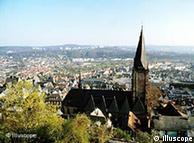馬爾堡(Marburg)位於德國法蘭克福和卡塞爾之間的中間位置, 與這兩城均相距直線距離77公里。鄰近的大學城吉森位於馬爾堡以南27公里處。
馬爾堡老城區位於今天的市中心的西邊,環繞在馬爾堡伯爵城堡下面,不過在拉恩山的另一邊的以前的以製革為主的村莊Weidenhausen也依然保 留著古城的風貌。馬爾堡最近兩百年來從老城區迅速地向四周擴張到了Lahntal區。城堡南部座落著有著年輕色彩和畢德麥耶爾風格的 Südviertel,西邊同為此格調的是Ockershausen。 城東為一個被火車鐵軌而因此與內城隔開的村落Ortenberg,二戰之後在馬爾堡北部又建立起了新的區Marburg-Wehrda和南部的 Cappel區。
Marburg: the castle, upper town, and St Elizabeth's church20th century
Marburg Speech
Franz von Papen, vice-chancellor of Germany in 1934, delivered an anti-Nazi speech at the University of Marburg on June 17. This contributed to several of von Papen's staff being murdered by the Nazis.
In 1945, Marburg became President and Field Marshal Paul von Hindenburg's final resting place. His grave is in the Elisabethkirche. He is an honorary citizen of the town.
Marburg is also now home to one of the most progressive schools for the blind in the world. Street crossings are equipped with "walk" and "don't walk" signs that also emit sounds enabling the blind to know what the signs are "saying."
Architecture
Marburg is famous for its medieval churches, especially the Elisabethkirche, one of the two or three first purely Gothic churches North of the Alps outside of France and thus an incunable of Gothic architecture in Germany, as well as for the castle.
More important, however, is Marburg's city as such, an unspoilt, spire-dominated, castle-crowned Gothic/Renaissance city on a hill, intact because Marburg was an extreme backwater between 1600 and 1850. Unlike, for example, Rothenburg ob der Tauber, Marburg regained some of its importance in later centuries, so it is not a "museum village" or EuroDisney, no tourist trap but rather a student-dominated university town.
Much of the physical attractiveness of Marburg today is the legacy of the legendary Lord Mayor Dr. Hanno Drechsler (in office 1970-1992), who promoted urban renewal and the restoration, for the first time, by object and not by area, i.e. areas were not pulled down but rather buildings restored. Thus, at a time when other cities were still pulling down medieval quarters, Marburg already protected its unique heritage. Marburg also had one of the first pedestrian zones in Germany. Marburg's Altstadtsanierung (since 1972) received many awards and prizes.
Living Planet | 21.02.2008 | 04:30
German City Makes Solar Roofs on Buildings Compulsory
The mayor of the German town of Marburg plans a new law that would make the installation of solar energy systems compulsory for all new houses and buildings that are being renovated. Is this the right way to motivate people to use solar power?
Aside from wind power, most research into renewable forms of energy generation has been into solar power here in Germany. In the city of Marburg, in the German state of Hessen, the mayor wants to make the installation of solar systems (hot water/heating systems and solar panels) compulsory for all new houses.
The proposed law would also apply to anyone renovating or adding additions to older houses, as well as upgrading old heating systems. Reactions have been loud and varied.
While the majority of people agree something needs to be done to reduce dependence on oil, coal and gas, critics question whether forcing people to make the change is the right path to an environmentally friendly future.
Reporter: Olivia McGrath




沒有留言:
張貼留言